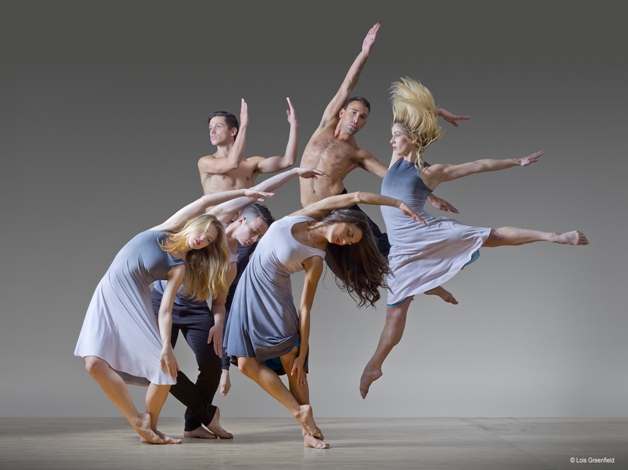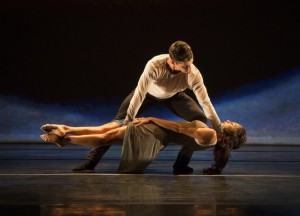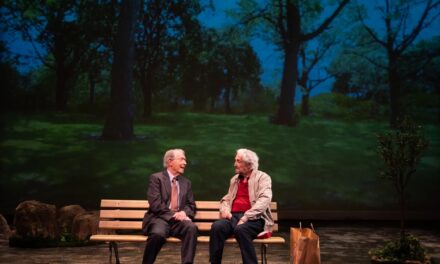Terrific dancers are put through their paces by three modern dance choreographers.
by Joel Benjamin
Parson Dance is extremely popular for a reason. David Parsons chooses beautiful, talented dancers who fill the stage with their open-hearted movement style, dancing his works—and the ballets of the occasional guest choreographer—with a commitment and joy that comes right across the footlights.
Parsons’ work tends toward the feel-good-we’re-all-one-big-family type. Four of the six ballets on this program were choreographed by him including his signature piece, the strenuous “Caught” which was particularly impressive with Elena D’Amario, her six pack abs gleaming, coordinating the strobe light effect so perfectly she seemed to be floating on air. Guest musician, Ljova added texture to Robert Fripp’s electronic score with his live fadolin playing.
“Finding Center,” the opening work to a bouncy, plunky score by Thomas Newman featured a constantly changing backdrop of colorful paintings by Rita Blitt, whose work consists of variations on ellipses floating on clouds of color. Dressed in Naomi Luppescu’s simple grey-black-white (wittily contrasting the constantly changing colors of the backdrop), the dancers fleetingly and full-bodily inhabited his swirling steps and formations, arms arching, twirling lifts and curved lines sweeping across the stage. A return to the opening movements, although understandable, provided a too glib ending.
“Union” (1993) was the darkest dance on the program, basically a long journey down the upper stage left/lower stage right diagonal in which the dancers, in chic, asymmetrical black bits and pieced by Donna Karan, moved solemnly to John Corigliano’s moving score. They dipped, slipped over each other, made beautiful sculptural groupings, but never quite made it out the other end. This was the only work that dabbled with profundity.
The final work, although breezy and fun, was unfortunately the weakest. Parsons’ “Nascimento” (1990) to the music of that famous Brazilian singer was a superficial gloss on Brazilian dance forms. The eight dancers, wearing Santo Loquasto’s colorful street-wear basically bopped about to the sexy bossa novas and sambas but barely registered on the sensuality—let alone sexuality—scale. They jumped in the air doing bent-legged cabrioles; tiptoed about cutely; and grabbed and flung each other about, without ever coming close to letting the Brazilian rhythms take over their bodies. It was lovely when it should have been devastatingly erotic.
Ironically, it was the guest choreographer and former company member, Robert Battle who managed to turn these gorgeous creatures into sensual beings in his rhythm-driven “Train” with a savagely enjoyable percussion score by Les Tambour du Bronx. There wasn’t much to “Train.” The dancers stomped and vibrated to the beat, their lines crossing and crisscrossing with solos flung off across the stage, but there’s something about a thumping beat and in this case, the pulsating beat hid a dearth of choreographic content.
The second guest dance creator was Katarzyna Skarpetowska, who also danced with the troupe, whose ethnic-tinged “Almah” pitted a lead couple, Ian Spring and Geena Pacareu against a mini-corps of four: Ms. D’Amario, Omar Román de Jesús, Zoey Anderson and Eoghan Dillon. Ljova, mentioned above, and his small band played his Klezmer-inflected score which provided a fine sonic environment for Ms. Skarpetowska’s smooth movement palette. The lead couple seemed to be on a journey, but whether it was romantic or friendly, was hard to determine. They kept slipping in and out of each other’s grasps and, except for a lovely high lift, never really connect. The rest of the group were there to support them, echo their movements and provide clever ways for the two to separate and re-combine.
The lighting, by Howell Binkley, with the exception of “Almah,” which was lit by Burke Brown was extraordinarily varied and expressive.
Parsons Dance took place January 20-31, 2016 at the Joyce Theater (175 Eighth Avenue, at West 19th Street). For future event tickets, call 212-242-0800 or visit www.Joyce.org For more information, visit www.parsonsdance.org
*Photos Yi-Chun Wu

























